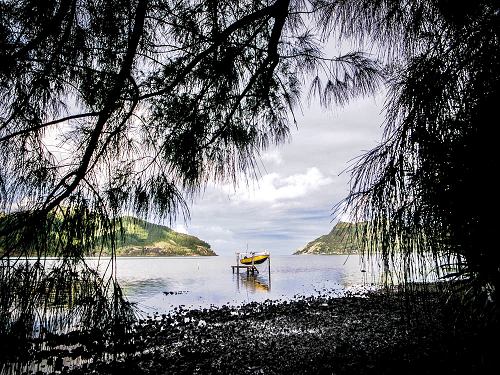Rapa Iti: from Europe to the ends of the Earth
There is no airport at Rapa Iti and it takes 50 hours to get there by cargo ship from Tahiti. Boats travelling there are few and far between, making Rapa Iti one of the South Pacific’s most isolated islands, along with Pitcairn and Easter Island. Its dark and wild coast is overlooked by the forts of twelve ancient clans at the top of the sleeping volcano. Humpback whales can be seen from afar. But this slice of paradise is also part of the European Union.

Rapa Iti: a slice of paradise that is also a part of the EU
Rapa Iti is the southernmost inhabitable island of French Polynesia, which as a French overseas country is also part of the European Union. Some 400 people live on the island, including many children, who are often spotted running after goats up the side of the mountains, helping out in the taro fields or next to the bread ovens, gleefully diving in the black water of the bay and scaring away the sharks. They eat mangu flowers, a variety of pandanus with an alien taste.
As French Polynesia is a part of the EU, it enjoys many benefits, such as €30 million in financial support for the 2014-2020 period. Its people are also able to make use of EU initiatives, such as the popular student exchange programme Erasmus+. It has proved so popular that charters are being renewed and even developed with the Universidad Politécnica in Valencia, Spain, but also with Ulster University in Colerain, Northern Ireland, and Newcastle University in England.
However, French Polynesia is far from the only region outside Europe to have strong links with the EU. The so-called outermost regions, which includes for example the Canary Islands and French Guyana, are fully part of the EU.
There are also overseas countries and territories, such as for example the Falkland Islands and Aruba. These are often territories that enjoy special relationships with one of the member states and as a result can form association agreements with the EU and can, if they want to, make use of the freedom of movement for work and freedom of establishment. They are only subject to EU legislation that is relevant to the association agreements they concluded. Some of them, for example Saint Barthélemy, are even part of the eurozone.
Back in Tahiti, the café of the French Polynesian University gives views of the setting sun over the Moorea Island. A couple of paradise birds float on the cool breeze that flows over the 15 hectares campus and its palm trees. Among the students that meet on the shady veranda after class is a 22-year-old woman, a flower head piece in her hair, setting off on her journey home after a 10-month Erasmus and finishing her second year of her international law degree. The strange thing is that foreigners are always quite similar. They live elsewhere, in different parts of the world, with different languages… but similar all the same.
This is a universal lesson that is reflected by the EU’s motto of united in diversity. The EU covers a wealth of countries, cultures, religions and languages, affecting people far beyond Europe’s physical borders, it is a Union whose wealth also comes from its these differences…
Source: European Parliament
- 1021 reads
Human Rights
Fostering a More Humane World: The 28th Eurasian Economic Summi

Conscience, Hope, and Action: Keys to Global Peace and Sustainability

Ringing FOWPAL’s Peace Bell for the World:Nobel Peace Prize Laureates’ Visions and Actions

Protecting the World’s Cultural Diversity for a Sustainable Future

Puppet Show I International Friendship Day 2020

